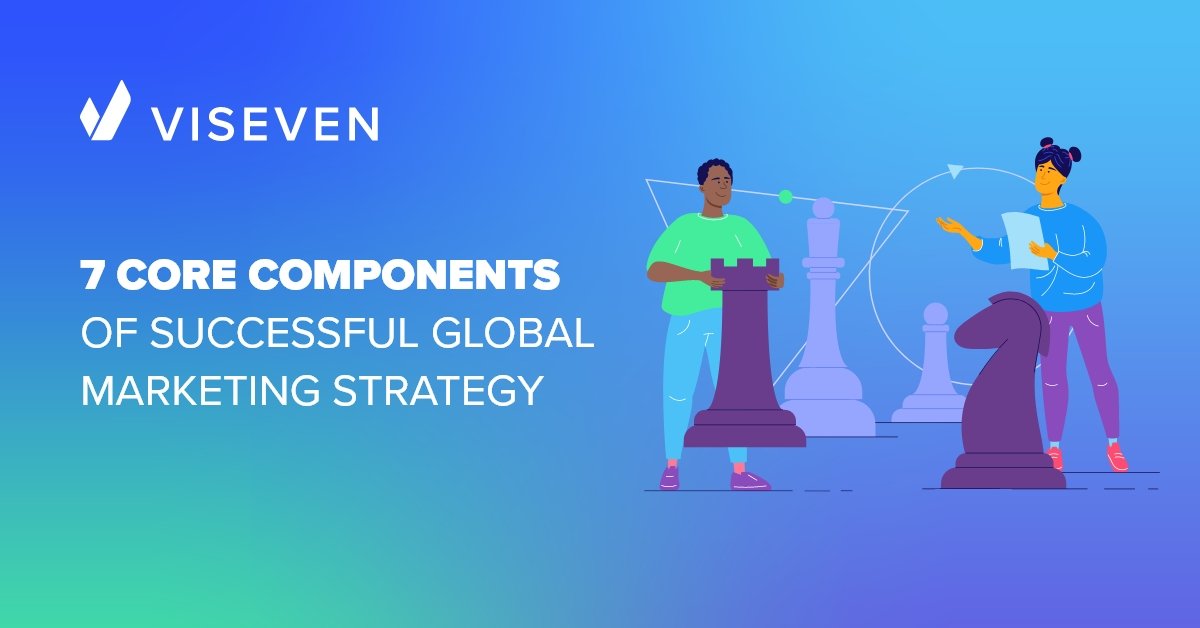
For most businesses, a global marketing strategy is an ultimate dream.
Before entering the global market and becoming world-famous, each top brand name like McDonald’s, Volkswagen, or Samsung (you name it!) had a long and rough journey starting with something small in one country or city.
Today, becoming a part of the worldwide market with an original brand has become less complicated thanks to search engines, digital advertising, social media, and video platforms.
Despite the abundance of marketing channels and the tremendous opportunities of advanced technologies, going to global markets is still a challenge that takes consideration and resources.
In this article, the Viseven team will review everything that concerns global marketing. You’ll discover the main strategy types, the key advantages of conquering international markets, and the core components for implementing international marketing techniques.
What Is Global Marketing?
Global marketing is a set of measures aimed at producing, introducing, advertising, and selling products and services to more customers in different countries across the globe. It is the process of adapting the company’s strategies to meet the needs of customers in the targeted countries.
One of the global marketing examples is Pfizer. The leading pharmaceutical manufacturer aligns its marketing campaigns to satisfy the needs of customers with diverse cultural backgrounds. The pharma brand not only translates marketing materials into local languages but also considers cultural nuances to craft relatable and compelling advertisements.
In the past, global brand strategy was an option restricted to multinational corporations only. With the rise of the Internet and e-commerce, even startups can reach their potential customers worldwide.
To reach the foreign audience, all they need to do is to let them know that they are up and running. It is also essential to convince customers that a product or service is worth spending their hard-earned money on. This is when global marketing comes in.
Finding the Balance Between Global and Local
Marketing teams, especially in large businesses, may choose opposite tactics when it comes to globalization.
Sometimes, central departments take control over every single local market. In other cases, they focus on a specific local market, fragmenting their efforts and failing to see the whole picture.
Each brand that plans to go global should find the balance between accumulating a profitable business environment in the home country and concentrating marketing efforts in foreign markets.
Let’s consider this question more clearly below.
The Main Types of Global Marketing Strategies
There are a few ways companies can enter the global market:
- An international marketing strategy presupposes importing and exporting a product or service around the world with the assistance of foreign suppliers while keeping the physical facilities in their homeland. The capital market of an international business is the native country.
- Multinational marketing implies the positioning of the company’s offices and facilities across multiple countries intending to produce, promote, and sell a product or service in place and at local prices. Regional offices in multinational companies act separately with no coordination with each other.
- Global marketing involves activities of multiple offices in multiple countries that act together under the guidance of the central corporate office that has a global strategy for the brand.
In addition to that, there are two global marketing strategies used to spread brand messaging:
Standardization Strategy
Brands use the same standard message in every target market translating it into native languages. Standardization is about consistency in delivering universal experience to all the markets. Though this kind of global strategic marketing requires less control and resources, it may be difficult to use it in some markets due to high competition or local regulations.
Localization Strategy
Brands adjust campaigns to each target market considering the national, cultural, and individual peculiarities of customers. Though localization requires in-depth market research, this global marketing strategy allows brands to create a stronger connection with customers on a personal level which leads to a better customer experience.
What Are Global Marketing Advantages?
Let’s start with the most obvious thing. The first advantage of any global digital marketing strategy is a large scale of activity reflected in the continuously increasing number of customers and sales.
Along with that, a global brand has:
More Insights
Information is the most important resource for any global brand because it drives growth and expansion. The importance of global marketing lies in getting and analyzing loads of unique data that brands can use to:
- Understand strengths and solve weaknesses
- Learn about customers and improve customer service in different regions
- Figure out how to enter new markets
- Compete with other companies more efficiently
- Improve products and services
More Influence
Promotional techniques that global brands apply across different markets change lives, dictate lifestyles, and create trends that can last for years. By creating compelling campaigns, these brands can instigate conversations, challenge norms, and foster inclusivity. This way, they not only capture market share but also leave a profound, lasting impact on the way people think, live, and interact, shaping the cultural landscape for years to come.
More Innovation
Globalization marketing strategy allows companies to get enough resources to move their industries forward by inventing new products and shifting customer experience to the highest level using the next-generation approaches based on technological advancement. This strategy powerfully promotes collaboration across countries and experience exchange, paving the way for transformative breakthroughs.
The Core Global Marketing Strategy Components
Here are a few recommendations for building a successful global marketing campaign.
1. Define and Separate Global and Local Activities
A global marketing strategy should include general plans scheduled around the world and specific initiatives that happen on the local level.
Some sectors would rather be guided globally, namely branding policy, overall planning, and budgeting. Other sectors are better managed on a regional level. Such activities may include local campaigns, PR events, tactical initiatives, and communication across social media channels in the region.
Dividing the markets into layers can significantly improve your business perspective. It helps efficiently allocate resources both on global and local levels. Identify various areas within your marketing concern before you’re stuck with time and money issues.
2. Resonate with the Needs of Local Markets
One of the biggest mistakes marketers could make within their global marketing strategy is to ignore regional diversity. Global brands must constantly monitor current trends and the personal needs of customers across local markets.
Global and local teams must develop a single comprehensive approach to gain mutual benefits. The times of one-size-fits-all marketing initiatives applied internationally have gone. It’s no secret that the mentality and cultural background of people from the USA, France, and India differ greatly. Thus, you must concentrate on different customer values to meet their needs.
3. Build a Proactive Marketing Strategy
Identify marketing areas beforehand. Make an upfront analysis of all business activities from the viewpoint of a certain region. Consider local characteristics and customer behaviors, including legal systems and economic situations. It’ll save you from unreasonable costs and help plan an actionable marketing strategy.
4. Energize Your Local Marketing Campaigns
Local teams to build up an effective and scalable marketing plan. All departments must be well-trained and positively motivated to fulfill brand goals. Find an experienced global campaign manager who can guarantee workflow excellence and successful communication between a central office and affiliates.
Planning business activities must be clear and consistent. All the staff, from global execs to regional employees, must know the work schedule, project objectives, and deadlines. Consider different time zones in the countries where your marketing team will deploy campaigns. Keep your company calendar straight to time changes. Otherwise, everyone will confuse your global marketing business plan.
5. Keep Track of All Marketing Processes
Monitoring and coordinating activities in multiple markets. You need reputable brand officers to manage the performance tracking of your marketing campaigns.
Make sure you remember the following:
Build KPI systems based on marketing objectives. Pick the most effective KPIs for global and local teams.
Collect the KPI data separately. That’s how your brand will better understand the contribution level of each team to the overall success.
Make the analytical information accessible on every level and review it regularly. The marketing strategy results will help the teams move in the right direction and drive a good deal of friendly competition between them.
Deliver the best practices to every single department. Keep in touch with in-market teams personally or through your officers to analyze and make current decisions and tactics optimized.
6. Examine the Overall Impact of Marketing Actions
Conclude at the end of each global to local story. Estimate the insights you have gained. Reverse-engineer the most advantageous ideas to avoid pitfalls and outperform in the future.
It is also recommended to rely on advanced analytics to measure return on investment (ROI), evaluate conversion rates, and monitor customer engagement. Conducting A/B testing can be also a smart move to hone your strategy.
Do not underestimate the importance of customer feedback. Use surveys and social media monitoring to gain valuable insights. The use of automated solutions would help you process this feedback faster and more efficiently.
Adjust your global marketing strategy based on this data to timely respond to the market and customers’ needs. It is equally important to regularly reevaluate your approach, demonstrating agility in this ever-evolving environment.
7. Elaborate Consistent In-Between Interactions
Make sure local and global teams stay in touch even when the company has got through with the localization campaign. Close communication helps improve professional growth and keeps everyone informed about industry trends around the world. If your local marketing teams are far from the central office, you can connect them via digital channels.
It is pivotal to encourage knowledge sharing, allowing teams to look at issues through different lenses. You should strive to promote cross-cultural competence, while ensuring constant alignment with overarching common goals. This kind of interaction not only drives professional development but also actively supports the company’s adaptability to new environments.
Execute a Global Omnichannel Marketing Strategy With Viseven
At Viseven, we’ve assisted dozens of global pharma brands with their marketing strategies.
Are you planning to go global with your pharma company or have issues with a current global campaign? Our professional team will be glad to help you create a marketing strategy from scratch or enhance your existing plan regardless of scale and the level of digital maturity.
Based on an omnichannel marketing approach, modular content approach, and advanced technical infrastructure, we can improve the level of customer experience, reduce time-to-market, and save marketing expenses by:
- managing global-to-local content production
- covering the entire content lifecycle with KPIs for every channel
- streamlining the content localization and adaptation processes
- automating the content distribution and delivery
Fill in the form below, and we’ll get back to you shortly!



